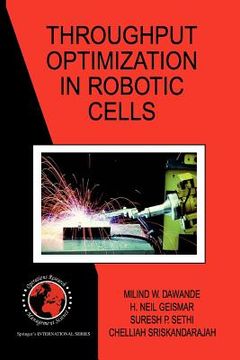Synopsis "throughput optimization in robotic cells"
Modern manufacturing processes have thoroughly incorporated automation and repetitive processing. The use of computer-controlled material handling systems to convey raw materials through the multiple processing stages required to produce a finished product is widely employed in industry world-wide. Central to these systems are robot-served manufacturing cells, or robotic cells. These cells perform a variety of functions including arc welding, material handling, electroplating, textiles creation, and machining. In addition, they are used in many different industries, including injection molding of battery components, glass manufacturing and processing, building products, cosmetics, lawn tractors, fiber-optics, and semi-conductor manufacturing. In the medical field, robotic cells are used to produce components for magnetic resonance imaging systems, for automated pharmacy compounding, to process nucleic acids, and to generate compounds for tests in relevant biological screens. Cells for grinding, polishing, and buffing handle many products, including rotors, stainless steel elbows for the chemical and the food industries, sink levers and faucets, propane tanks, flatware, automotive products, and more. All of this has resulted with the rapid growth of robotic cell scheduling. As manufacturers have employed them in greater numbers and greater varieties, analysts have developed new models and techniques to maximize these cells productivity. Competitive pressures will result in the development of more advanced cells and, hence, more sophisticated studies. Therefore, robotic cell scheduling should continue to attract the attention of a growing number of practitioners and researchers. THROUGHPUT OPTIMIZATION IN ROBOTIC CELLS is a comprehensive introduction to the field of robotic scheduling. It discusses the basic properties of robotic cells and outlines in detail the tools most often used to analyze them. In doing so, the book will provide a thorough algorithmic analysis of optimal policies for a variety of implementations. The book provides a classification scheme for robot cell scheduling problems that is based on cell characteristics, and discusses the influence of these characteristics on the methods of analysis employed. Implementation issues are stressed. Specifically, these issues are explored in terms of implementing solutions and open problems.

